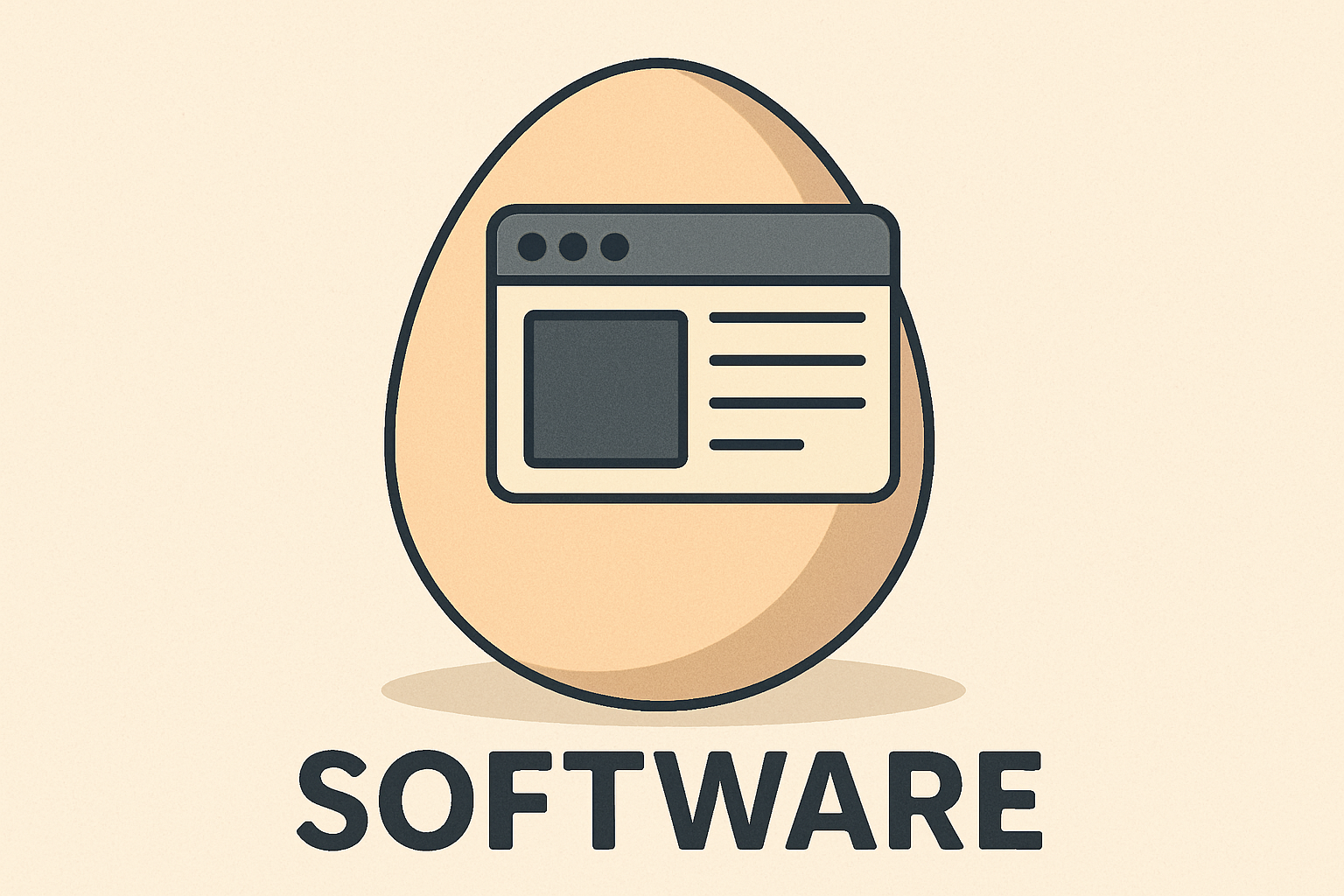In the relentless and competitive arena of technology, where new products vie for attention in an overcrowded marketplace, branding is everything. A compelling name can generate immense buzz, setting the stage for a successful launch or consigning an product to obscurity. It is in this context that we encounter one of the more curious and evocative terms to emerge recently: the software egg. The term immediately conjures images of potential, of something nascent and protected that holds the promise of new life. But it also raises a critical and skeptical eyebrow. In the pragmatic world of code and functionality, is this merely a clever marketing ploy? Is the concept of a software egg a substantive architectural paradigm, or is it just a gimmick designed to capture our imagination and our wallets?
This question strikes at the heart of how we evaluate new technologies. The tech industry is notoriously susceptible to hype cycles, where fascinating metaphors often obscure a lack of real utility. To determine the validity of the software egg, we must move beyond the label itself. We must crack it open, so to speak, and examine its contents with a critical eye. This article will undertake that very process, analyzing the software egg concept through multiple lenses: its proposed technical definition and architecture, its practical applications and benefits, the counterarguments of its critics, and its comparison to past industry trends. By doing so, we can move towards a definitive answer on whether this is a meaningful innovation or simply a shell of a idea.
1. Defining the Software Egg: Beyond the Metaphor
Before we can judge its merit, we must first define what a software egg actually is. The term is not yet a standardized industry acronym but rather an emerging concept that describes a particular approach to software packaging and deployment. At its core, a software egg is a self-contained, encapsulated unit of software that contains not only the application code but all of its dependencies, configuration files, libraries, and even a minimal runtime environment needed to execute it.
The “egg” metaphor is apt because it implies a few key characteristics:
Self-Containment: Just as an eggshell protects and contains the yolk and white, the software egg‘s encapsulation ensures that everything needed to run is inside a single, portable package. This eliminates the infamous “it works on my machine” problem that has plagued developers for decades.
Portability: An egg can be moved. Similarly, a software egg can be developed on one operating system (e.g., Windows) and reliably run on another (e.g., Linux) without modification, because it brings its own environment with it.
Potential: The egg contains the potential for life. In software terms, the software egg contains the potential for a running application instance. It is a dormant state that, when executed, “hatches” into a fully functioning service or process.
Technologically, the concept of a software egg is an evolution of existing ideas like containerization (e.g., Docker) and immutable infrastructure. However, proponents argue it takes a step further by aiming for even greater simplicity, security, and standardization. The goal is to create the smallest, most efficient, and most secure possible packaged unit of software that is trivial to distribute and run anywhere, from a developer’s laptop to a massive cloud cluster.
2. The Case for Substance: Why the Software Egg is Not a Gimmick
If we accept this definition, a compelling case can be made that the software egg represents a genuine and useful advancement in software engineering, not merely a marketing gimmick. Its value proposition is built on several concrete pillars that address real-world pain points.
Revolutionizing Developer Onboarding and Consistency: The single biggest drain on productivity in software teams is often environmental setup. A new developer can spend days, sometimes weeks, trying to get their local machine to mirror the complex setup of the production environment, installing the correct versions of interpreters, databases, and SDKs. The software egg model obliterates this problem. A new team member simply downloads the relevant software egg for their project and runs it. The application starts instantly, behaving exactly as it does for every other developer and in production. This guarantees absolute consistency across development, testing, staging, and production environments, dramatically reducing bugs and streamlining the entire development lifecycle.
Unparalleled Security Through Immutability and Minimization: Security is a paramount concern, and the software egg architecture offers inherent advantages. First, by its very nature, a software egg is immutable. It is a read-only package that cannot be changed at runtime. This prevents drift and tampering, both from external attackers and from accidental internal changes. Second, the process of building a software egg forces developers to consciously include only the absolute minimum dependencies required for the application to function. This principle of minimization reduces the “attack surface”—the number of potential vulnerabilities present in unused libraries and tools. A software egg is a hardened, minimal, and immutable unit, making it significantly more secure by design than a traditionally deployed application.
The Ultimate in Deployment Simplicity and Scalability: From an operations perspective, the software egg promises a dream-like simplicity. Deploying a new version of an application, or scaling it horizontally to handle more traffic, becomes as simple as launching more instances of the software egg. There are no complex provisioning scripts, no dependency conflicts to resolve, and no configuration management tools to orchestrate. The orchestration system (like Kubernetes) only needs to know how to launch the egg; it doesn’t need to know anything about what’s inside it. This decoupling of the application from its infrastructure simplifies deployment pipelines, reduces operational overhead, and enables truly agile and reliable continuous delivery.
These are not the hallmarks of a gimmick. They are direct, practical solutions to some of the most persistent and expensive problems in software development and operations. The value here is tangible and measurable in saved hours, reduced outages, and improved security postures.
3. The Case for the Gimmick: Skepticism and Counterarguments
Despite the compelling benefits, healthy skepticism is warranted. Critics rightly point out that the tech industry has a long history of repackaging old ideas with new names. The argument that the software egg is just a gimmick rests on several observations.
“There’s Nothing New Under the Sun”: The most common criticism is that the software egg is simply a new name for established concepts. Containerization, specifically Docker containers, already provides isolation, portability, and dependency management. Java offered “write once, run anywhere” with its JAR files and virtual machine decades ago. Even older are statically linked binaries, which compile all dependencies into a single executable file. From this perspective, the software egg feels less like a revolution and more like a branding exercise for a specific philosophy of using containers—one that emphasizes extreme minimization and immutability. Is it a new concept, or just a new, catchy term for best practices that have been emerging for years?
The Risk of Over-Abstraction and Debugging Woes: A potential downside of such rigorous encapsulation is the difficulty of introspection and debugging. If an application is a black box—a sealed software egg—how does a developer peek inside when something goes wrong? Traditional debugging often relies on attaching to a running process, examining the live environment, and modifying configuration files on the fly to test hypotheses. The immutable, self-contained nature of the software egg can make these traditional troubleshooting techniques more challenging. While sophisticated logging and observability tools are meant to fill this gap, critics argue that the model can abstract away too much, making the system opaque and harder to truly understand when deep, complex failures occur.
The Hype Cycle and eventual disillusionment: The term itself, software egg, is undeniably catchy and prone to hype. This invites comparison to other buzzwords that promised to change everything but eventually settled into being useful, yet narrow, tools in a broader toolbox. Could the software egg be heading for a “trough of disillusionment” on the Gartner Hype Cycle? The fear is that eager teams might adopt the model for the wrong reasons—because it’s trendy—and try to apply it to problems it wasn’t designed to solve, leading to unnecessary complexity and eventual backlash against the concept as a whole.
4. Verdict: A Meaningful Evolution, Not an Empty Gimmick
After weighing the evidence from both sides, the conclusion is that while the term “software egg” might be a clever piece of marketing, the underlying principles and architectural pattern it represents are substantively valuable and not a gimmick.
The term is indeed a convenient umbrella for a set of modern best practices: containerization, immutability, minimalism, and declarative deployment. However, by bundling these practices into a single, evocative concept, it provides a powerful mental model and a clear target for development teams. It sets a higher standard than simply “using containers.” It pushes for the smallest possible image, the strictest immutability, and the simplest deployment mechanism.
The software egg is not a magical solution to all software ills. It is a specific tool optimized for a specific purpose: building and deploying modern, cloud-native applications and microservices. It is likely a poor fit for monolithic legacy applications or software that requires frequent runtime modification. But as a pattern for green-field development and modern DevOps practices, its benefits in consistency, security, and operational simplicity are very real.
Conclusion: A Hatch Worth Watching
So, is a software egg just a gimmick? The answer is a resounding no. While the name is catchy and the concept builds on pre-existing technology, it represents a meaningful and important evolution in software design philosophy. It codifies and promotes a standard of excellence in packaging and deployment that directly addresses critical issues of security, reliability, and developer productivity.
The true value of the software egg concept lies not in its novelty, but in its clarity and focus. It provides a clear architectural goal for teams to strive towards: creating software that is simple to build, secure by default, and trivial to run anywhere. Whether the term itself endures or is eventually replaced by another acronym is less important than the enduring impact of the principles it champions. The software egg has hatched, and it reveals a promising future for more robust and manageable software.






